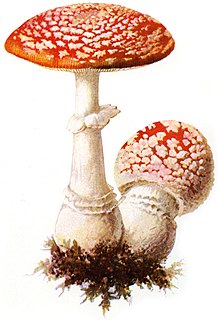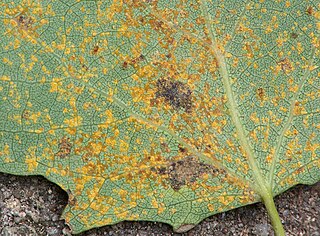Related Research Articles

In biology, a subgenus is a taxonomic rank directly below genus.

The genus Amanita contains about 600 species of agarics including some of the most toxic known mushrooms found worldwide, as well as some well-regarded edible species. This genus is responsible for approximately 95% of the fatalities resulting from mushroom poisoning, with the death cap accounting for about 50% on its own. The most potent toxin present in these mushrooms is α-amanitin.

Cordyceps is a genus of ascomycete fungi that includes about 400 species. Most Cordyceps species are endoparasitoids, parasitic mainly on insects and other arthropods ; a few are parasitic on other fungi. The generic name Cordyceps is derived from the Greek word κορδύλη kordýlē, meaning "club", and the Greek word κεφάλι, meaning "head".

Pluteus is a large genus of fungi with over 300 species. They are wood rotting saprobes with pink spore prints and gills that are free from the stem.

Jean Paul Vuillemin was a French mycologist born in Docelles.

Humaria is a genus of fungi in the Pyronemataceae family. The genus is widespread in northern temperate areas, and contains 16 species. The genus was circumscribed by Karl Wilhelm Gottlieb Leopold Fuckel in 1870.
Engleromyces is a genus of fungi in the family Xylariaceae. The genus contains two species, the type Engleromyces goetzei and E. sinensis, described as new in 2010. The genus was described in 1900 by German mycologist Paul Christoph Hennings.
Phlebonema is a fungal genus in the family Agaricaceae. It is a monotypic genus, containing the single species Phlebonema chrysotingens, described by Roger Heim in 1929 from Madagascar. According to the Dictionary of the Fungi, the placement of this little-known genus in the Agaricaceae is uncertain.

Melampsoraceae are a family of rust fungi in the order Pucciniales. The family is monotypic, containing the single genus Melampsora, which contains about 90 species.

Leucangium is a genus of ascomycete fungi. The genus was circumscribed by French mycologist Lucien Quélet in 1883. Although classified in the Helvellaceae in the past, molecular analysis indicates it is closely related to the genus Fischerula and Imaia, and therefore must be placed in the Morchellaceae. The genus includes two species, Leucangium ophthalmosporum Quél. and L. carthusianum Paol., and both of them produce sequestrate ascoma, globose to ellipsoidal ascus, and dark olive-colored to grayish green, smooth, fusiform ascospores.

Amoebidiidae is a family of single-celled eukaryotes, previously thought to be zygomycete fungi belonging to the class Trichomycetes, but molecular phylogenetic analyses place the family with the opisthokont group Mesomycetozoea. The family was originally called Amoebidiaceae, and considered the sole family of the fungal order Amoebidiales that included two genera: Amoebidium and Paramoebidium. However, Amoebidiidae is now monogeneric as it was recently emended to include only Amoebidium. Species of Amoebidium are considered obligate symbionts of freshwater-dwelling arthropod hosts such as midge larvae and water fleas (Daphnia). However, because Amoebidium species attach to the exoskeleton (exterior) of the host and grow in axenic culture, at least some species may be facultative symbionts.
Harpella is a genus of fungi in the Harpellaceae family. The widespread genus contains five species that grow in Diptera.
Digitatispora is a genus of crustlike fungi in the family Atheliaceae. The genus, circumscribed by French mycologist Gaston Doguet in 1962, contains two wood-decay species that grow on marine-submerged wood.
Olpidiaceae is a fungal plant pathogen families that was placed in the order Chytridiales.

Casimir Roumeguère was a French botanist and mycologist.
Basidiobolomycetes is one of the currently recognized classes within the kingdom Fungi.
References
- ↑ Léger L, Gauthier M (1932). "Endomycètes nouveaux des larves aquatiques d'Insectes". Comptes rendus hebdomadaires des séances de l'Académie des sciences (in French). 194: 2262–5.
- ↑ Kirk PM, Cannon PF, Minter DW, Stalpers JA (2008). Dictionary of the Fungi (10th ed.). Wallingford, UK: CABI. p. 659. ISBN 978-0-85199-826-8.